David Roberts ; In search of two Buxton heroes on the Altopiano
I am now trying to write a book, about two singular young men with string connections to Buxton, who died within two months of each other in the same small area of Italy, the Altopiano in the area of Asiago in the summer of 1918. Edward Brittain is possibly the better known, being the brother of the author Vera Brittain and frequently mentioned in her book “Testament of Youth”. He went to prep school in Buxton before going to Uppingham College, but he returned frequently to the family home in Buxton and was indeed there on the day war was declared on 4th August 1914. Edward joined the 11th Battalion Notts. and Derbys. Regiment ( “The Sherwood Foresters”). He won the Military Cross during the Battle of the Somme, where he was also badly wounded. On returning to the 11th Battalion, he served again in France before the battalion transferred to Italy in November 1917, to support the beleaguered Italian Army after its defeat at Caporetto, On 15 June 1918, he was killed on San Sisto Ridge just outside Asiago. William Howard Lister also lived in Buxton and attended my old school Buxton College (in those days it was a private school). He served on the Western Front, and despite being severely wounded in October 1914, (he suffered a serious arm would which could almost have seen him invalided out), he returned to the front for the Battle of the Somme, where he served with the 55th Field Ambulance. After being wounded again, he returned to the front with 21st Field Ambulance who attached to British 7th Division as part of the Italian Expeditionary Force. He was killed while doing his duty as a Medical Officer, somewhere near San Sisto Ridge on 9th August 1918.
As a native of Buxton, currently living in Italy, I wanted to tell the story of how Edward Brittain and William Howard Lister got to the Altopiano and of their final days there, which is why I am writing the book
Asiago 28/8
I have a couple of days free, so I am heading to Asiago for some research. Today’s journey from Milan to Asiago takes about four hours in total. The first stretch is with the Frecciarossa from Milan to Vicenza . This takes little more than hour across the North Italian plain. The Italian Expeditionary Force took a rather more circuitous route from Genova to Mantova by train and the rest marching. Today I am in air-conditioned comfort, speeding across the North Italian plain at speeds of up to 300 km/h. From Vicenza there is a local bus service to the Asiago. This is not exactly quick, the bus winds its way through the plain up to Thiene. After Thiene, the road starts to head up to the Altopiano. We are getting higher and higher. The road up to the plateau is a series of hairpins; every so often, we pass a sign for the altitude, 800 slm, 900 slm, and 1000 slm (slm is Italian for above sea level). Looking downhill as the bus takes the hairpins, I can start to appreciate why the Altopiano was such a prize. Once the Austrians got through the ridge, there was literally nothing stopping them getting to the rich North Italian plain and from there onto Milan and Rome. The defence of the Altopiano was key to keeping Italy in the War, which is why the British and with them Edward Brittain and William Howard Lister ended up fighting there.
I arrive in Asiago in time for Lunch, which turns out to be a platter of the excellent local cheeses and cold meats. Asiago is as famous for cheese as for its wartime experiences and I am assured that each of the local cheeses has a different flavour according to the pasture on which the cattle grazed. Fortified by lunch, I get ready for the afternoon’s research. I only have a day and a half to spend, so I want to make the most of my time.
The weather is good. I want to take the opportunity to see the cemeteries where Edward Brittain and William Howard Lister are buried. I arrange with a local taxi driver for a small tour taking in both cemeteries. Granezza and Magnaboschi are on different sides of Asiago, so it is not such an easy trip. Anyway, Luca gives me a fair estimate up front and we set off. We head out of Asiago towards Granezza, We pass a sign to the British cemeteries, but this is down a forest track and Luca, quite understandably does not want to risk his immaculate white Mercedes taxi down this route. Therefore, we take the main road instead. Arriving at Granezza, there is a restaurant at the top of the road with a recreation of the Tattenham corner sign from the First World War, we park on the road and Luca leaves me to walk up to the small walled enclosure of Granezza. It is a quiet intimate place, much smaller than the huge cemeteries on the Western Front, but just as immaculately kept.
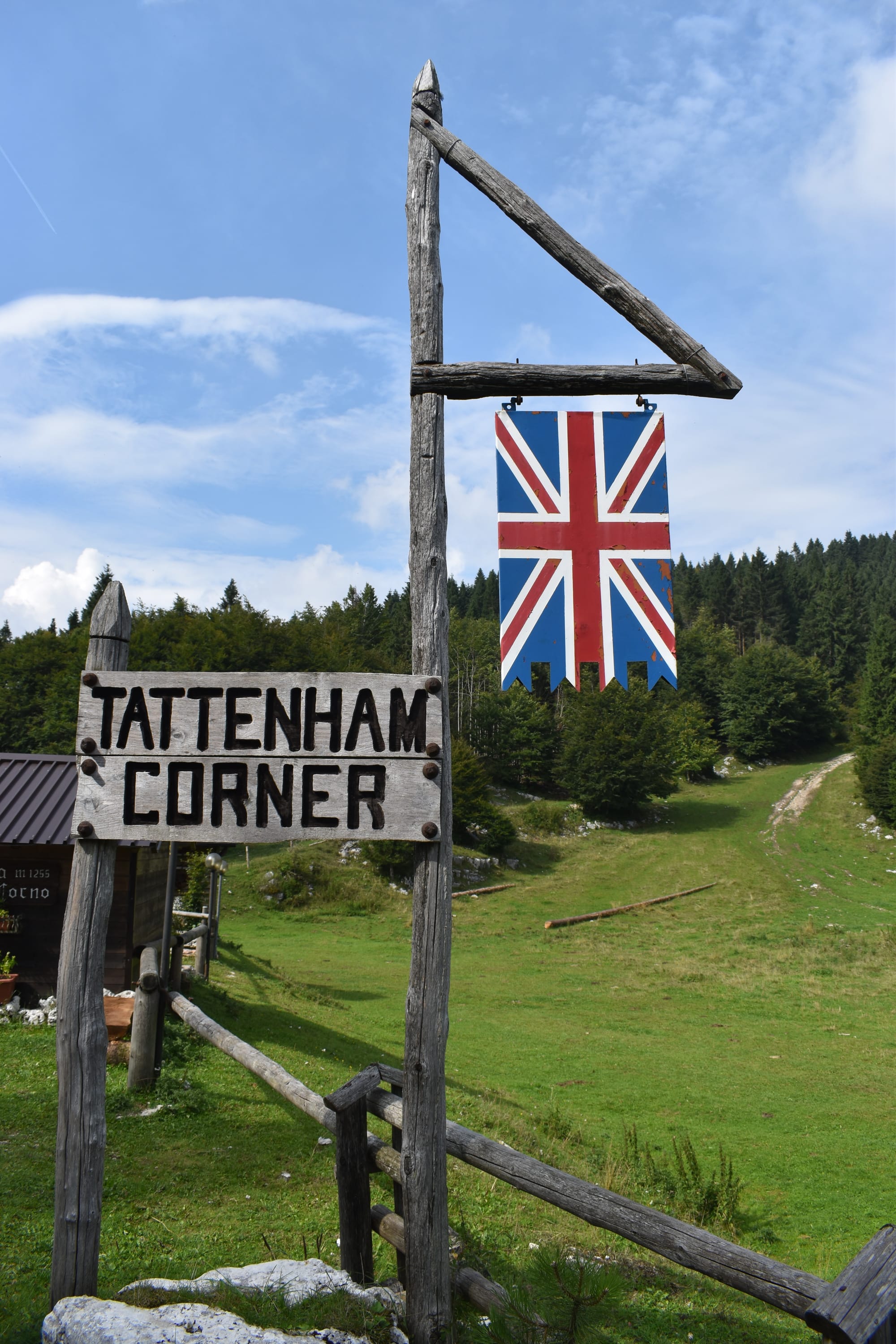 The replica "Tattenham Corner" sign at Granezza
The replica "Tattenham Corner" sign at Granezza
 The British Cemetery -Granezza
The British Cemetery -Granezza
It is not difficult to find Edward Brittain’s headstone on the left hand side of the cemetery, buried alongside other fallen soldiers from the Sherwood Foresters. I am the only person there, looking at the grave of 22 year old, who died 101 years ago. It is strange to think that we have shared the same locations at a distance in time. Edward must have been as familiar as me with the geography of Buxton; the Pavilion Gardens; Spring Gardens; the Buxton Opera House; the route to the Goyt Valley. Even though they have changed over the last 100 years, fundamentally, they remain the same, At 22 years of age; I had finished University and was looking for a job. At 22 years of age, Edward was already a Captain and holder of the Military Cross. He had already lost his two best friends to the war; he had been wounded, returned to the front and seen unimaginable suffering. Here he was forever 22 years old.
 Edward Briitain's grave
Edward Briitain's grave
The words of the poem seemed very appropriate
“They shall not grow old, as we that are left grow old:
Age shall not wary them, nor the years condemn.
At the going down of the sun and in the morning
We will remember them.
They mingle not with their laughing comrades again;
They sit no more at familiar tables of home;
They have no lot in our labour of the day-time;
They sleep beyond England’s foam. “
In 1918, the valley of Granezza was a very busy place, used as a Head Quarters and supply area for British troops in the area. Today it is very peaceful, beautiful place. It is indeed a fine, final resting place. On her death, Edward’s sister, Vera Brittain had her ashes scattered here and I can quite understand why that would be.
Leaving Granezza we had back through Asiago to take the other road out of town. In 1918, Asiago had been almost razed to the ground by the Austrian bombardments during the offensive in 1916, these days it is charming and peaceful little town. The ruins, in which the Austrian soldiers sheltered prior to launching their attack of 15 June 1918, have been rebuilt and a peaceful and prosperous town lives on. We find the road down to Magnaboschi and park near the cemetery, Luca has not been to this one before, so he accompanies me to take a look. Magnaboschi is perhaps less well known being away from the other British cemeteries and without the literary connections of Granezza.
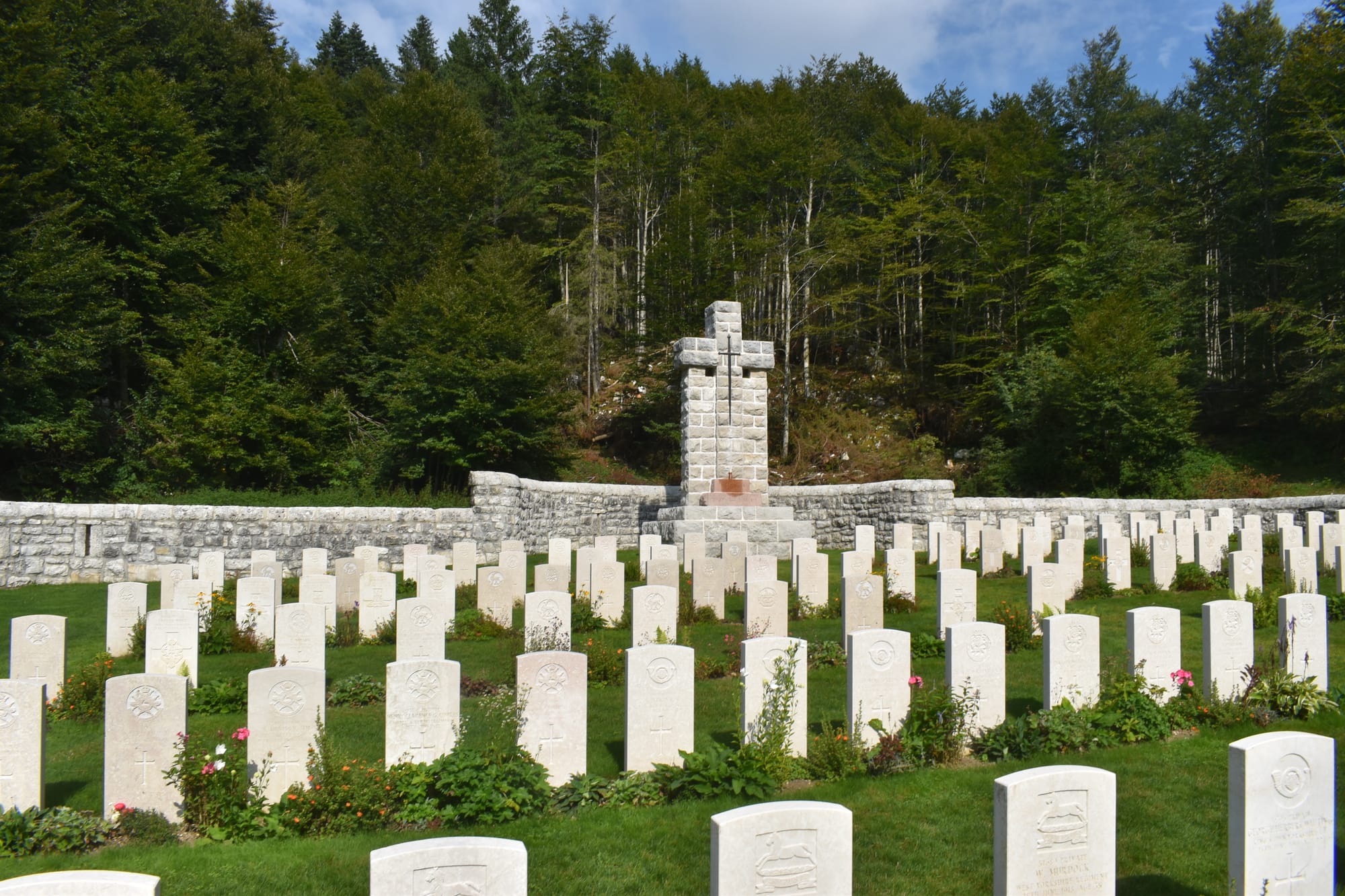 The Britsh Cemetery at Magnaboschi
The Britsh Cemetery at Magnaboschi
Magnaboschi is a small cemetery, of the same design as Granezza surrounded by a low stonewall. Again, it is kept immaculately. William Howard Lister is easy to find. He is next to an RAMC Corporal Richard Spencer Knaggs, who died the same day, presumably caught by the same trench mortar blast that took Lister’s life. Lister’s travel has had taken him through Thessaloniki to the shores of Newfoundland. In the war, he had volunteered repeatedly for the front, he could have stayed in convalescent depots or base units, but he did not. He went back eight times in all. He is eighth time was to be the last time. As an RAMC officer in charge of stretcher-bearers, he must have seen more in the way of suffering in four years, then we can scarcely imagine. He had almost lost the use of his arm, survived gas attacks and watched while a 20 man bearer party was blown to bits around him from which he walked away unscathed. Here he lies, at Magnaboschi forever 31 years old. There are probably many people around in Britain today, who would not be so if Lister and his dedicated bearer parties had not rescued their fathers, grandfathers or great grandfathers from the battlefield. Rupert Brooke’s poem seems entirely fitting;
“If I should die, think only this of me:
That there’s some corner of a foreign field
That is forever England. There shall be
In that rich earth a richer dust concealed;
A dust whom England bore, shaped made aware,
Gave once, her flowers to love, her ways to roam,
A body of England’s, breathing English air,
Washed by the rivers, blest by suns of home”
The words could not be more apt. A grateful Italian people ceded the land at Magnaboschi and other cemeteries in perpetuity to the British. In a way, these places are forever England and William Howard Lister lies in this little piece of England up in the Altopiano.
 Willian Howard Lister's Grave
Willian Howard Lister's Grave
On leaving Magnaboschi, Luca drops me at the 1915-1918 museum in Canove, from where I can walk back along the disused railway line to Asiago, I visit the museum, which is small but interesting mainly containing examples of the various types of shells that both sides pounded the area with. Then it is a 3km walk up the old railway track, which formed a vital part of the Austrian’s resupply operation for Asiago, to get back again.
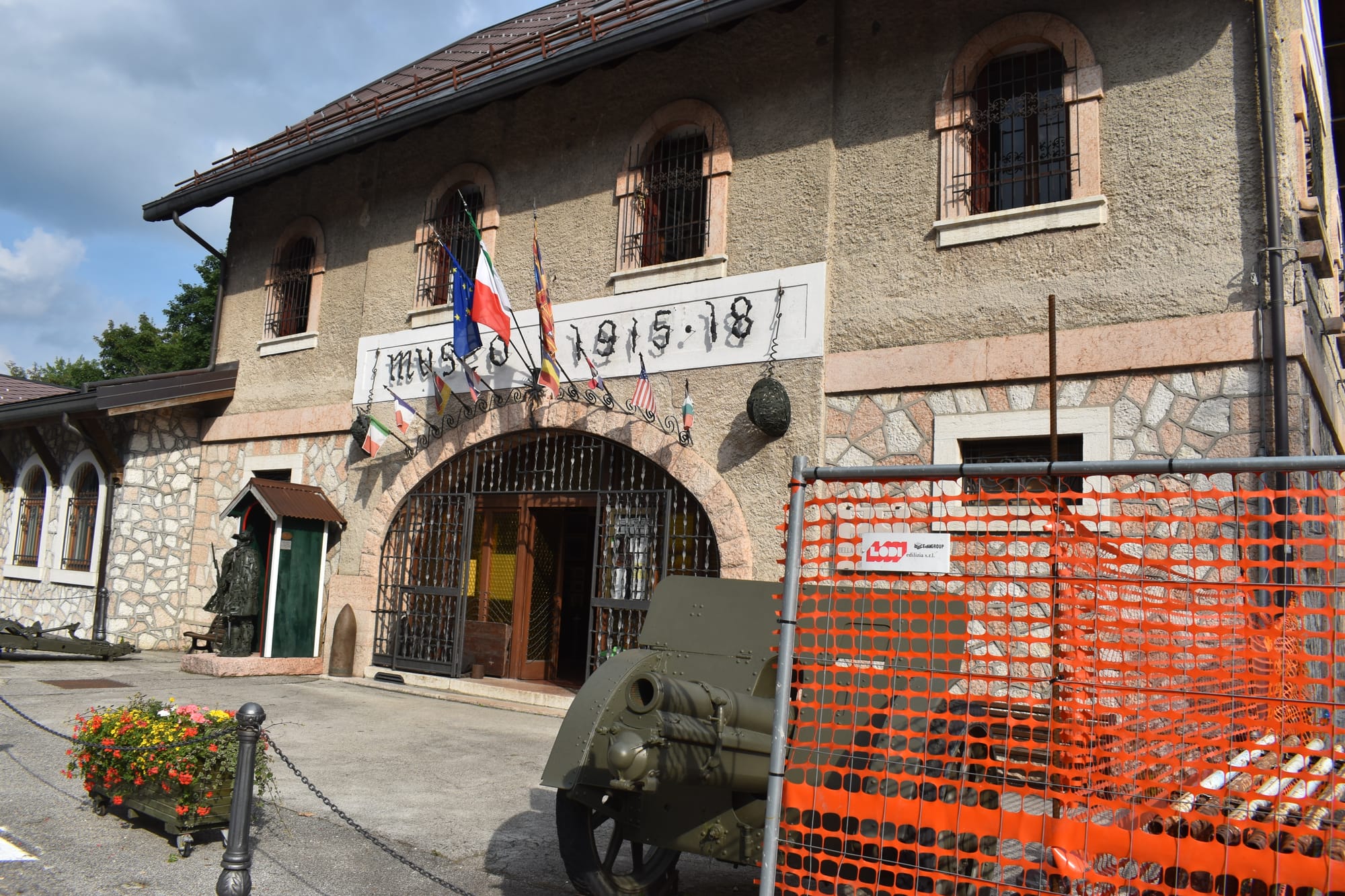 1915- 1918 Museum
1915- 1918 Museum
Asiago 29/8
Having seen where Edward Brittain and William Howard Lister lie at rest, I set out the next morning to see if I can find where they died.
The next morning I spent in the area of San Sisto Ridge trying to work out the exact geography of the battlefield. I was following the directions given in Francis MacKay’s excellent book “Asiago”, which proved excellent up to a certain point. The book was published 18 years ago and especially before Storm Vaja devastated the area in autumn 2018, causing a lot of damage to the forest and potentially covering up much of what was previously visible. Things start well, as McKay indicated, I started at the Old Station in Asiago, with the Sacrario ( the Italian War Memorial ) ahead of me and turned right down Via Cavour. So long as you can find via Cavour, you can equally well find it from the centre of the town.
 The view toward San Sisto Ridge
The view toward San Sisto Ridge
Following the road through the countryside, I reached Contrada Ave. There is a small cluster of buildings here, a farmhouse and some newer looking buildings. Asiago is a tourist area and there is quite a lot of new development going on. In the north of Italy, zoning regulations are quite well enforced, so I hope we do not see too much building in the future encroaching on this former battlefield. The Austrian forces grouped in Asiago before launching their attack on 15th June 1918 and I am following the same route, that some of them would have taken. San Sisto Ridge is ahead of me, as MacKay describes it, a low whale backed ridge, sometimes difficult to make out against the higher Prunele Ridge behind. I walk along a country track, with nothing but grazing cattle for company and the view of the ridge ahead. It is 9 am in the morning, a couple of hours after the Austrians started their walk advance to the ridge in 1918 That morning they had launched a four hour artillery barrage onto the ridge and the surrounding areas. I am walking through what was “No Man’s land”; the terrain is very undulating and broken up with numerous rocky outcrops. Closer to the forest, some of these were used as British outposts or Machine Gun posts ahead of the British lines and these had a devastating effect on the advancing Austrians. . I can only imagination the scene of utter devastation that the Austrians must have faced as they took this route.
 The Austrian view towards the Bridge lines on San Sisto Ridge
The Austrian view towards the Bridge lines on San Sisto Ridge
In the end, the track reaches the edge of the forest. The British frontline trench the Alhambra was about 30 metres into the forest. The forest floor is very overgrown with a dense undergrowth of brambles. Storm Vaja hit this area in 2018, blowing over some four million trees. Although many of the fallen trees have been cleared, many more remain where they fell making the terrain even more difficult to follow. Moss and bushes now in turn cover these fallen trees, which makes finding any trench systems much more difficult. The area has a sort of primeval feel about it, sometimes the naturally occurring rocks can give the impression of being fortifications. I leave the track and struggle through the thick undergrowth.
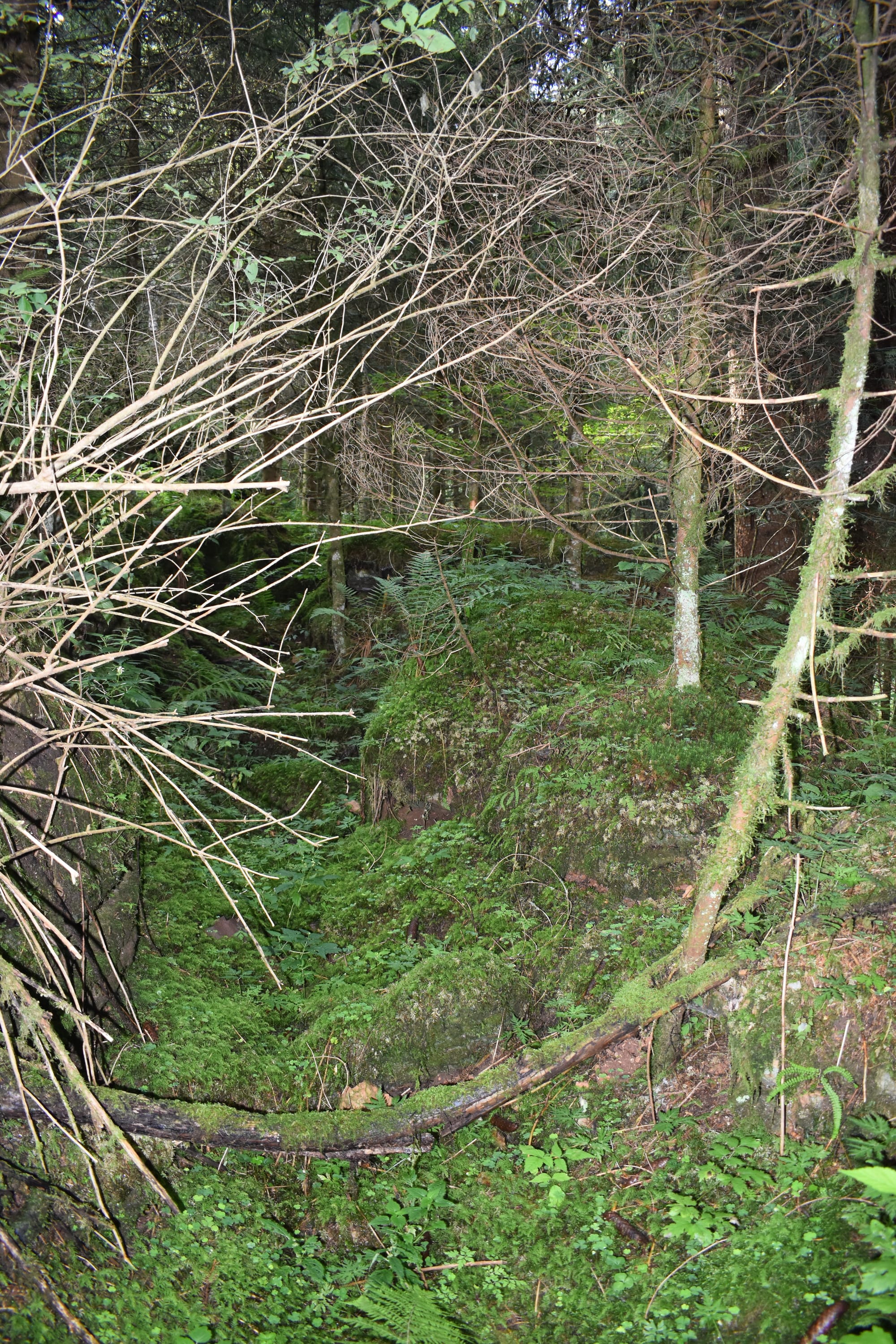 Looking for the Alhambra Trench
Looking for the Alhambra Trench
In the end I find part of the trench system and especially one of the upwards communication trenches running up the ridge. I know this, because walking up the narrow slit trench; I get my socks caught in some rather rusty, but genuinely 100 year old barbed wire. Fortunately, it was my sock rather than my bare legs that is snagged in the wire. It is still very sharp and it takes me a while to disentangle myself. Imagine having to do that under heavy fire when your life depends on it.
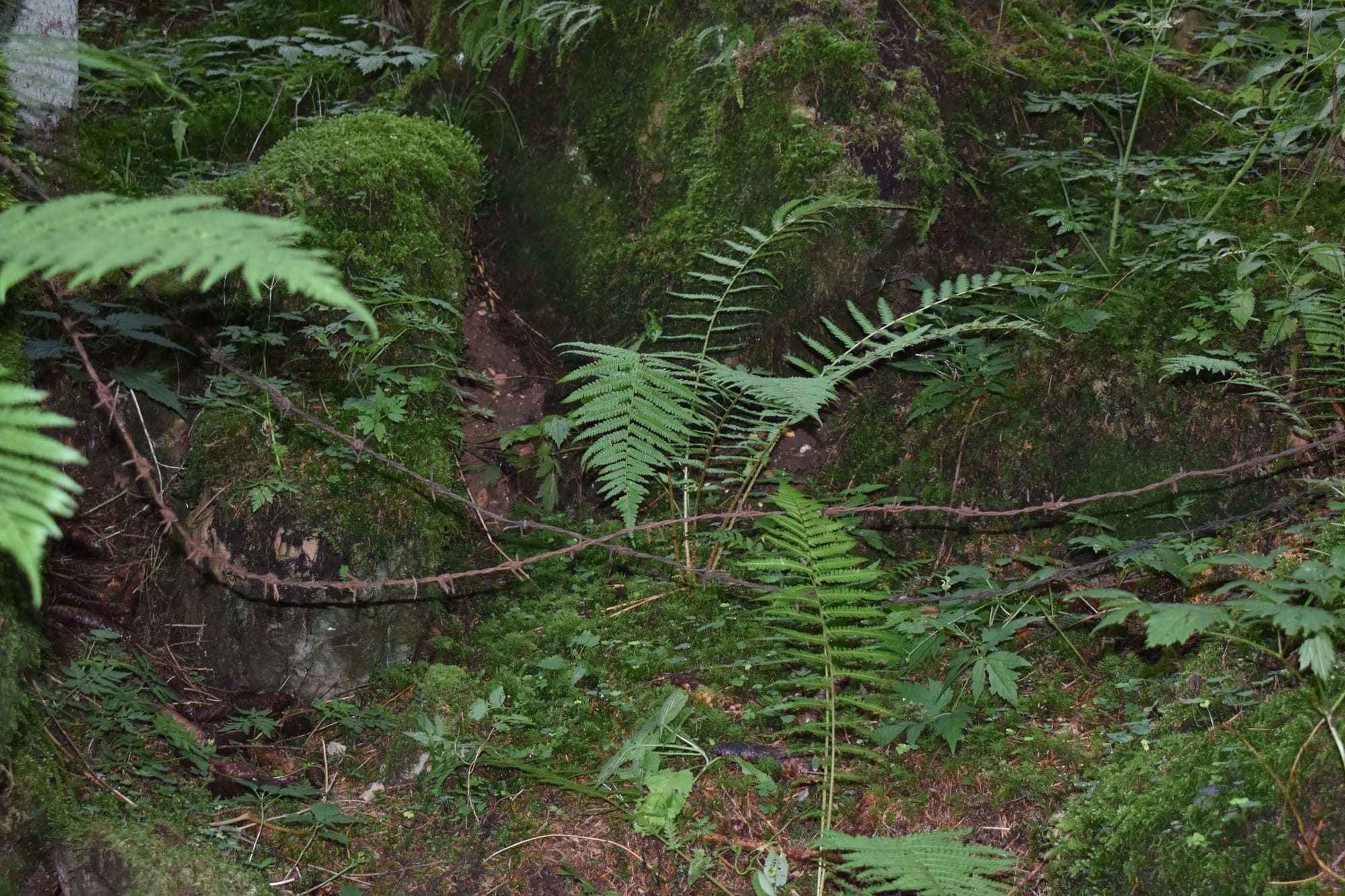 Hundred year old barbed wire
Hundred year old barbed wire
Maybe leaving the path is not such a good idea, the dense foliage is covering up many potential holes in the ground and the moss-covered stones are very slippery. I do not fancy falling into some hidden trench system, especially with all that valuable photographic equipment to crash to the ground, so I had back to the main path.
Returning to the track, I continue to follow McKay’s directions up the glen towards the Lazzaretto chapel , This small chapel sits at the edge of the forest on the way down from the ridge, Apparently there is a pilgrimage route from here to Santiago di Compostela in Spain , a mere 2300 km away. The original Lazzaretto chapel was destroyed during the war, you can still see the remains of the original chapel (fenced off and about 50 metres to the right).
 The old Lazzaretto chapel
The old Lazzaretto chapel
To the right of the chapel, there is a track heading up into the forest. MacKay indicates this as heading up the ridge top line of trenches, the Adelphi. On the way up you pass by an Italian bunker cut into the rocks.. In the end, the track vanishes and there are just a few animal or hunter’s tracks to follow. You can see parts of the trench system, but again it is very overgrown and difficult to make anything out very clearly. Once, I have left the track and started scrambling around the trenches, I do have difficulty finding my way back again. I get temporarily lost in the dense undergrowth and have to fight my way through the brambles and back to the track. Up here, it is rather more dangerous than the Alhambra line, there are some steep drops from the ridge top and you need to remain fairly agile and observant. It is not a battlefield tour for the faint hearted. Even though, it is difficult to follow the trench systems, I get an impression of the good defensive positions held by the British. Even once the Austrians had breached the first line of trenches at Alhambra, they still had to procced up the hill and through two more lines of British trenches to get down the other side. Following four hours of artillery barrage, the forest must have been smashed to pieces – which presumably would have made progress up the hill still more difficult.
In the end, I manage to find my way out of the ridge top trench system and back unto the glen and the Lazzaretto. I continue downwards through what would have been the British rear positions and along the forest track. A couple of kilometres, I come to a fork in the road, with a signpost to the British War Cemeteries. This the forest track to get to the cemeteries, the one which Luca had declined to use the previous day, Now, I can quite see why, the road is unmettaled and I pass several trucks carrying logs and quarried stone along its single track. It is probably not wot using a rental car on this road, and having to explain al the stone chip damage to the rental company, when returning the car. Fiat 500 probably bad idea, something four-wheel drive with a high wheelbase and you are probably fine.
Following the road to the cemeteries, I come across the restored Opsidaletto Inglese (the English hospital). This is a concrete construction, which would have been deep within the British rear lines. It is apparently the only example in Italy. The striking thing is how small it is .There are two buildings, one barely big enough for a couple of people; the second maybe capable of holding 10 or 15 stretcher cases. It is here that the casualties bought in by Lister’s bearer parties would have received emergency treatment and waited for ambulances take them away from the front. During the battle, it must have been a truly awful place. Some Italian children are playing outside; they are frightened to go into the hospital. One of them says there may be a body in there; a sensible Italian mother says, “of course there aren’t”. Today that is certainly true; in 1918, the place was literally full of bodies.
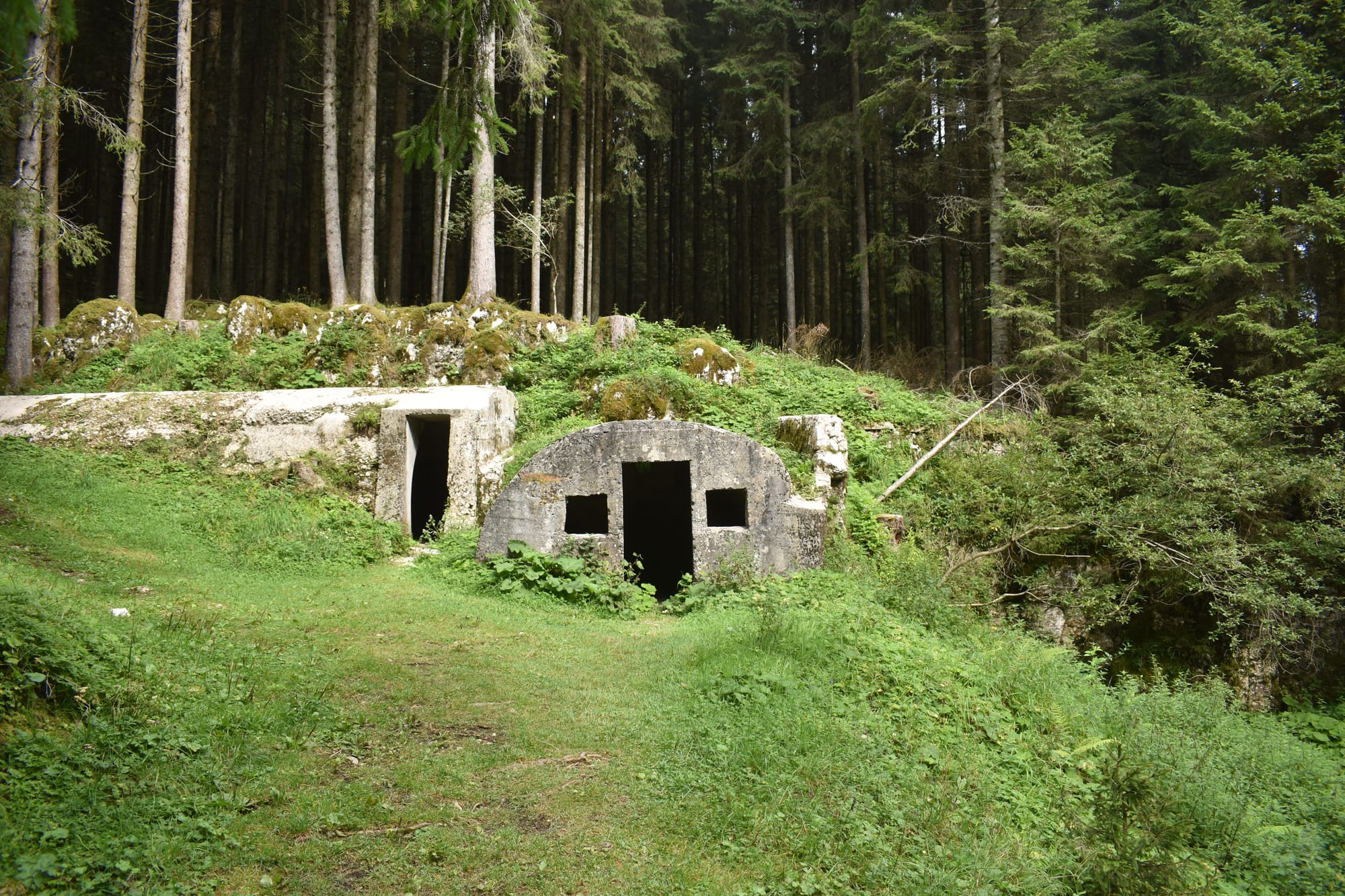 The English hospital
The English hospital
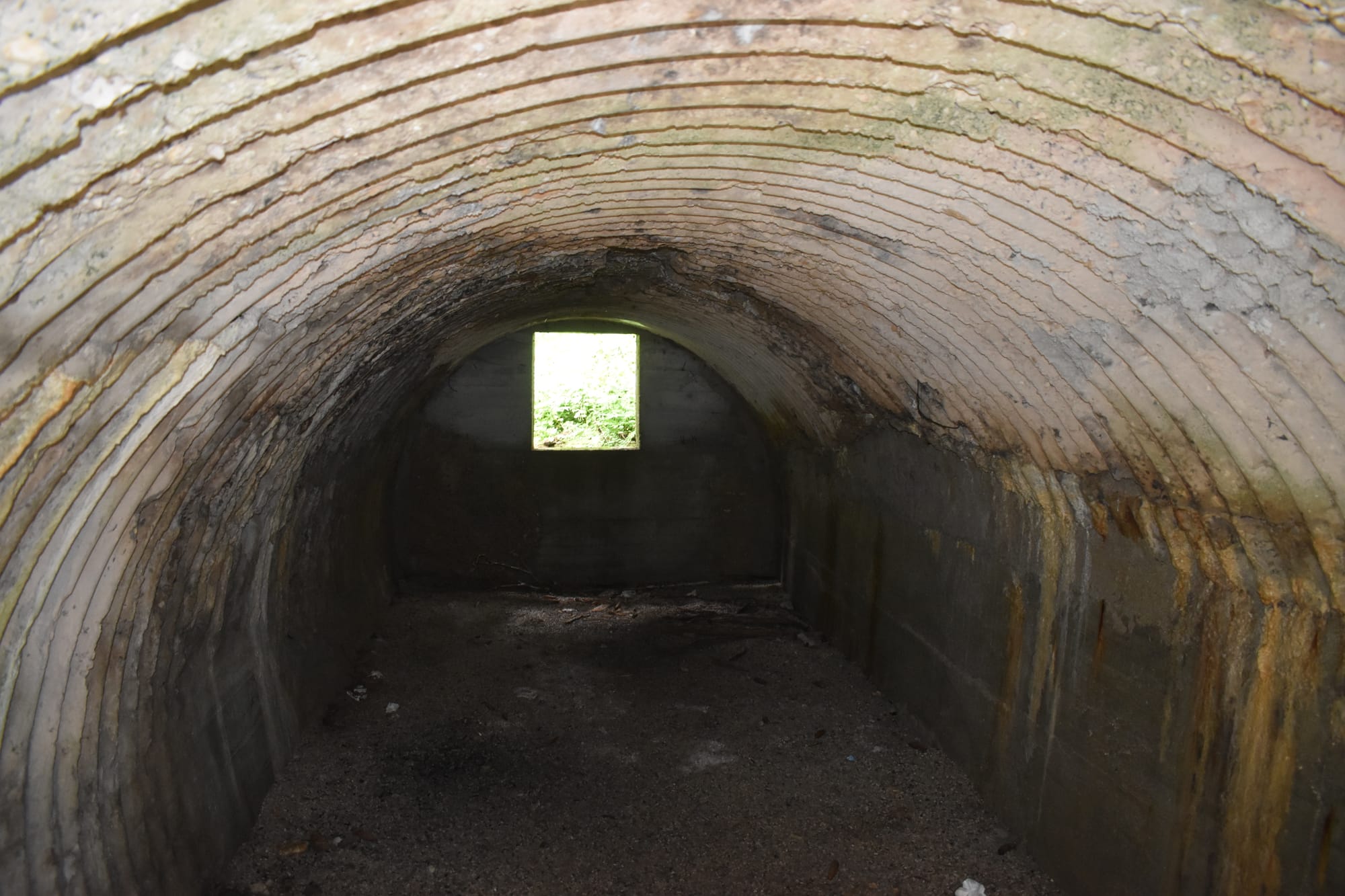 Inside the English hospital
Inside the English hospital
Presumably, Lister would have been familiar with this hospital and similar structures in the area. It is difficult to be certain exactly where Lister served and was killed in this area. After the Austrian offensive of 15 June had failed, things went quiet on the Asiago front for a couple of months until on 9 August the British launched a series of raids against the Austrian positions, It was probably when the Austrians returned fired on the attacking British, that Lister was hit by a trench mortar projectile and killed instantly.
About another 1 km or so along the forest track, I reach the British Cemetery of Barenthal. It is constructed in much the same style as Granezza and Magnaboschi. There are several soldiers from the 11th Sherwood Foresters buried here as weld, including those who died on 15th June 1918.
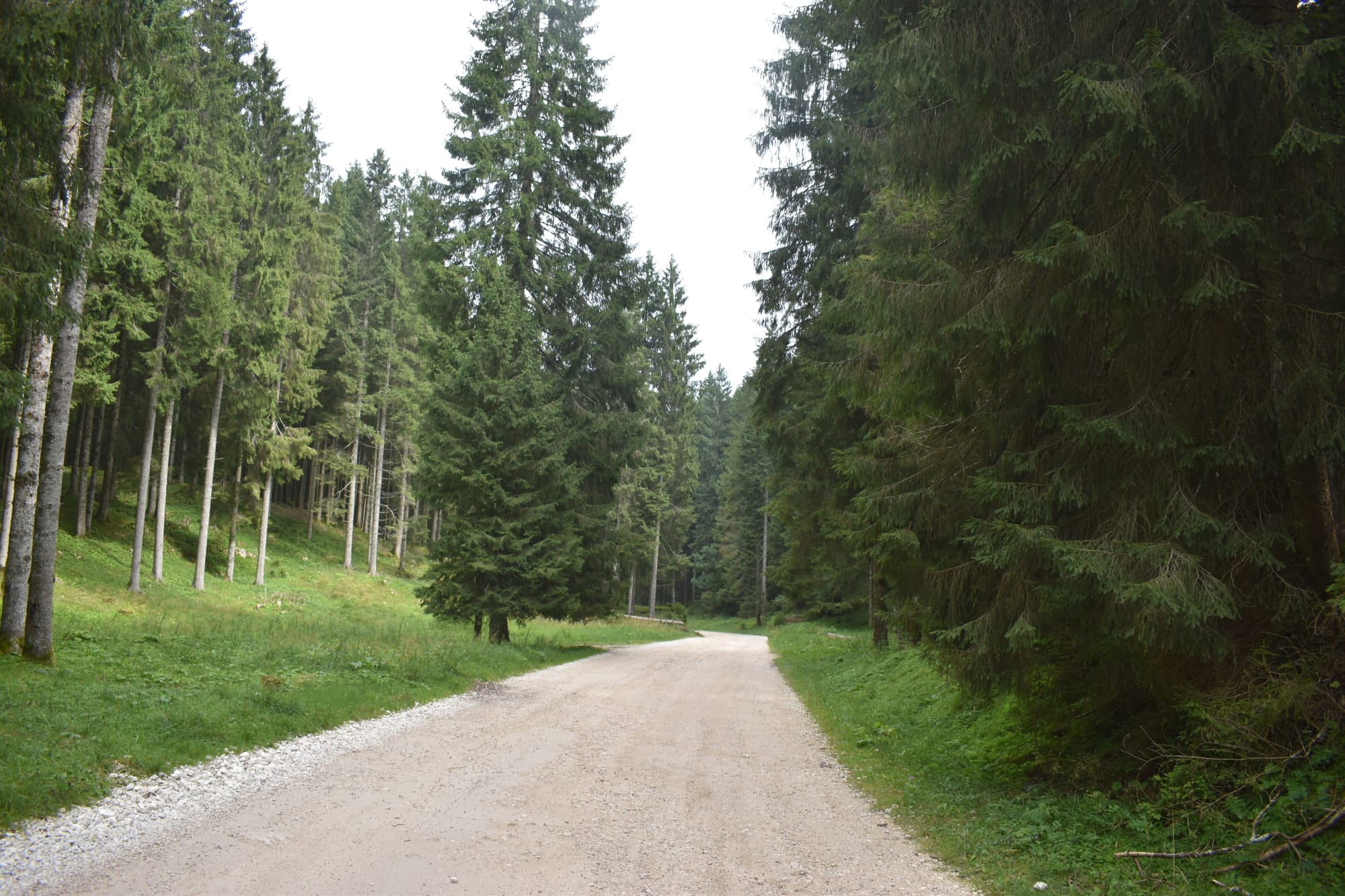 Barenthal Road
Barenthal Road
 The British Cemetery Barehntal
The British Cemetery Barehntal
After a quick look round the cemetery at Barenthal, I head back up the Barenthal Road to Asiago. Reaching the forest edge, I can now see the terrain as it would have faced the British defenders of San Sisto ridge. In the distance ahead, you can see Asiago and before that the broken irregular terrain which was “No Man’s land”. There is a much better view of the location of the British outposts and Machine gun nests ahead of the Alhambra Trench.
 Probabòe site of British outposts in "No-Man's Land"
Probabòe site of British outposts in "No-Man's Land"
 Probable site of British Machine Gun Posts
Probable site of British Machine Gun Posts
I have another attempt to investigate Alhambra trench, this attempt ends worse than the first. There is a small path heading into the forest, which promptly disappears. I then head into the forest; this proves to a serious error. The fallen trees and thick undergrowth make any progress extremely difficult. Some huge patches of nettles prove to be unavoidable. My legs end up cut to shreds by brambles as I try to make it out of the forest to the open pasture again. The pasture is fenced off by modern barbed wire, so it is difficult to follow the treeline along to the main road. My legs are covered in welts from nettle stings and bleeding profusely from the brambles, so I elect to head back to the main track towards asiago. Somewhere over to my right, Edward Brittain lost his life. I imagine he was looking out at a similar view, over Asiago and to the mountains behind. Today all is peaceful; I cannot imagine what the scene would have been like on 15th June 1918. Asiago would have been lying in ruins, the ground in front devastated and churned up by the artillery barrages, the smoke hanging in the air and the noise of gunfire. The grey figures of the Austrian infantry filing across “No Man’s land”. From Lieut. Colonel Hudson’s memoir, we know that Edward knew that he was under enquiry by the Provost Marshal’s department for suspected homosexual offences before he went out to the frontline on 15th June 1918. Both Hudson and Vera Brittain seem convinced that Edward did not actually take his own life on the 15th June 1918 or indeed deliberately expose himself to enemy fire. In the circumstances of the battle, a small error of judgement or distraction would have been all it would have taken, maybe his mind distracted by other things he left himself exposed for just a second too long enabling a Austrian sniper hidden in the broken ground of “No Man’s land” to get a bead on him. Whatever happened, sometime early in the morning of 15th June, Edward Brittain lost his life, a few hundred metres from where I am now standing.
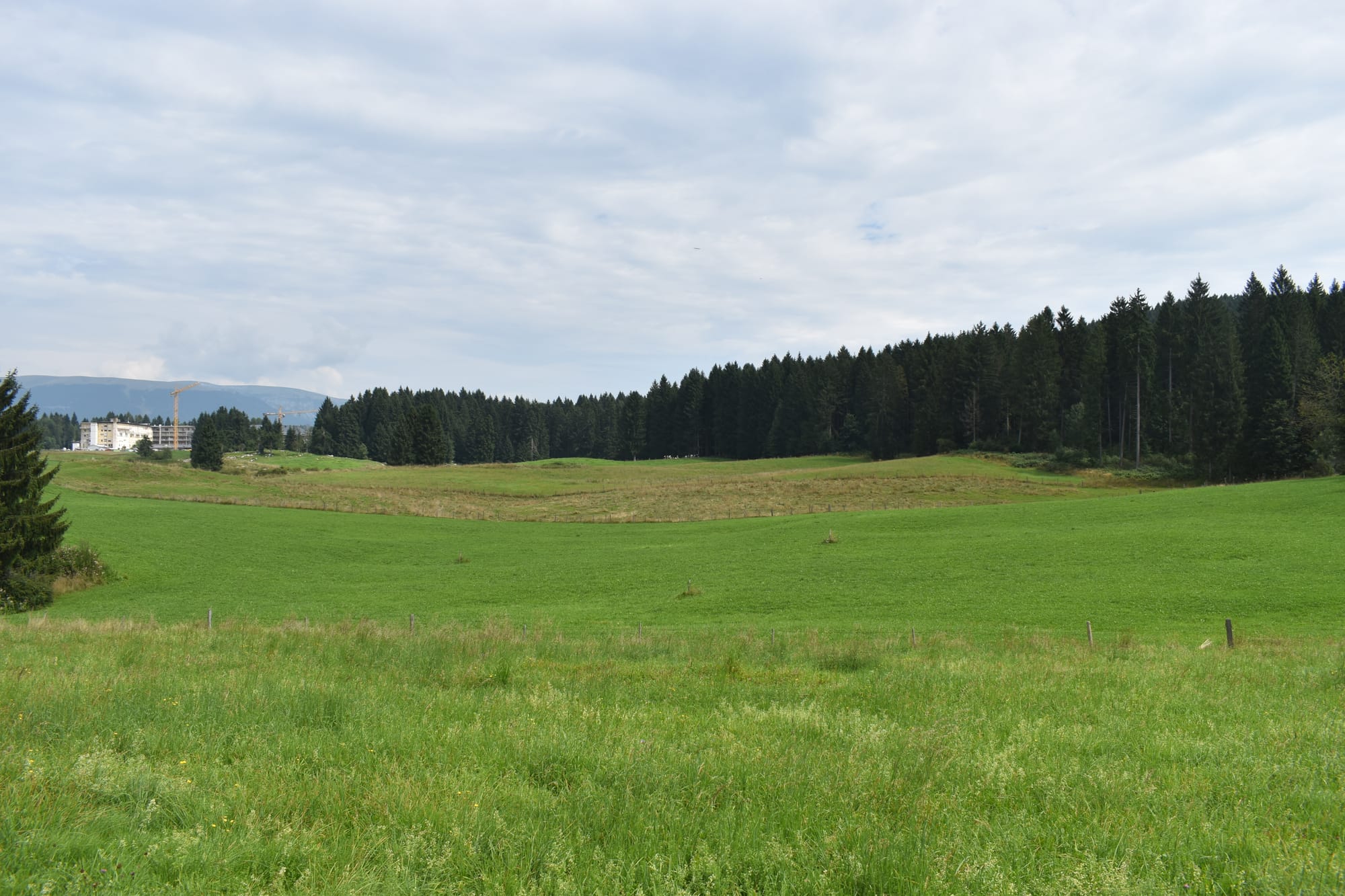 The approximate location of Edward Brittain's death
The approximate location of Edward Brittain's death
I make it back to Asiago to obtain some iodine for my cut legs and some anti-histamine cream for the copious burning nettle stings. I am lucky, I can then settle down for lunch in the peaceful square in Asiago. Edward Brittain and the other soldiers of the 11th Sherwood Foresters killed ion 15 June 1918 had no such luck. After lunch, I visit the Italian memorial in Asiago. You cannot really miss it, a huge arch that totally dominates the skyline of Asiago. Although I am here to look for two British officers, I think it is important not to overlook how much the Italians suffered on the plateau as well. To put things into perspective, British deaths on the plateau ran into the high hundreds, Italian and indeed Austrian casualties into the high tens of thousands. The bodies of 54,286 fallen Italian and Austro- Hungarian soldiers are contained in the Sacrario. Small plaques along the internal walls bear witness to the thousands of known Italians who died for the patria in that area between 1915-1918. Perhaps most striking of all is the fact that more than 33,000 of bodies are unknown.
 The Sacrario in Asiago
The Sacrario in Asiago
There is a small museum in the Sacrario and outside there is a small collection of captured Austrian equipment, This includes an Austrian Trench Mortar. Could this be the type of weapon ( or something very similar) that fired the projectile that killed William Howard Lister on 9 August 1918,
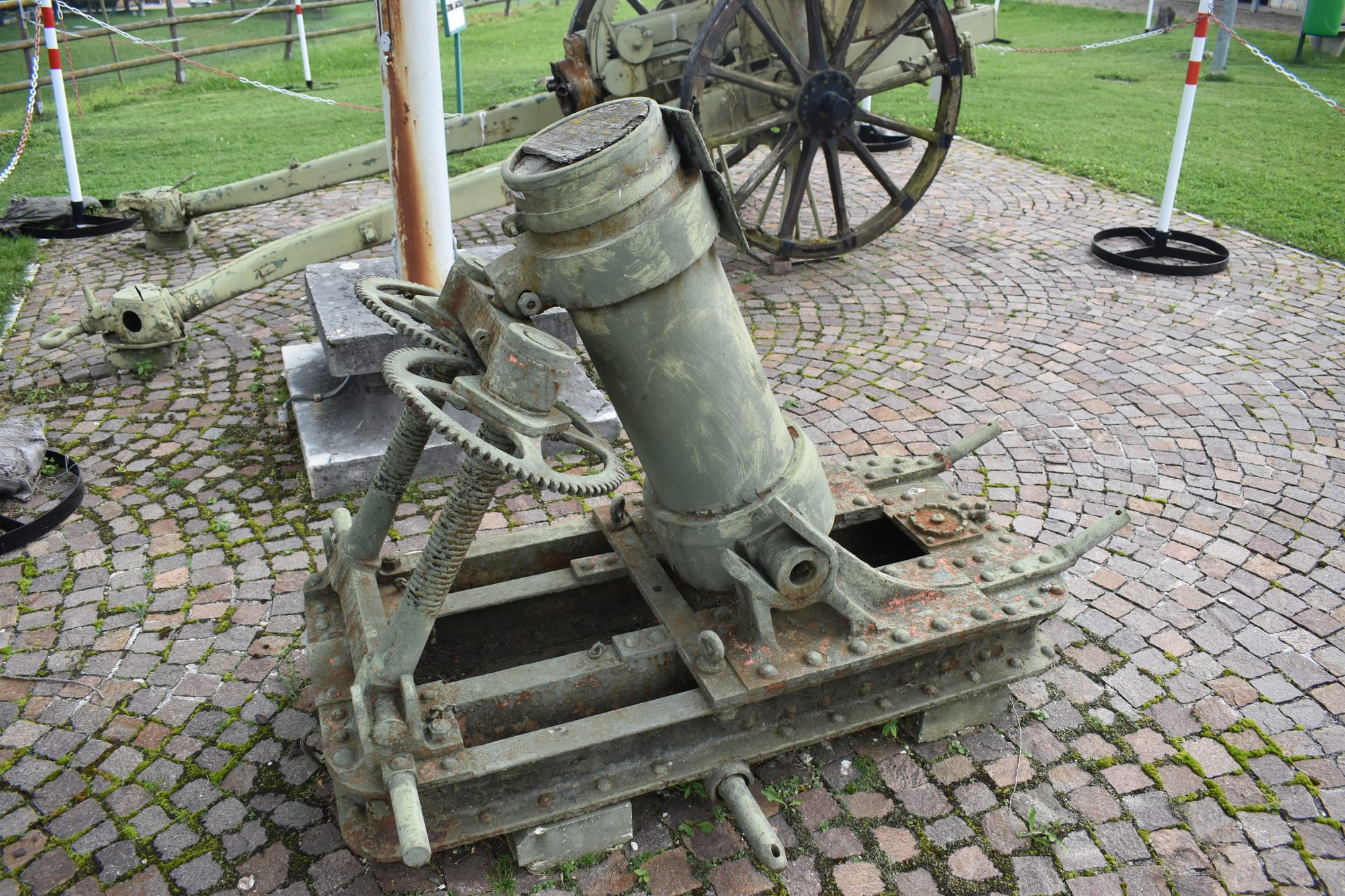 An Austrian trench mortar- similar to one that fired the projectile that killed Lister
An Austrian trench mortar- similar to one that fired the projectile that killed Lister
That evening, I sit in the Cafe Adler in the main square in Asiago drinking an extremely good Americano cocktail and writing these notes. It has been an impressionable couple of days, as far as possible; I have tried to find the locations where Edward Brittain and William Howard Lister spent their last few days. Maybe I did not find exactly the right places, but I certainly came close. It has definitely given me a feel for the area and bought to life what were previously only locations on maps or descriptions in books. It has been a valuable and poignant experience.
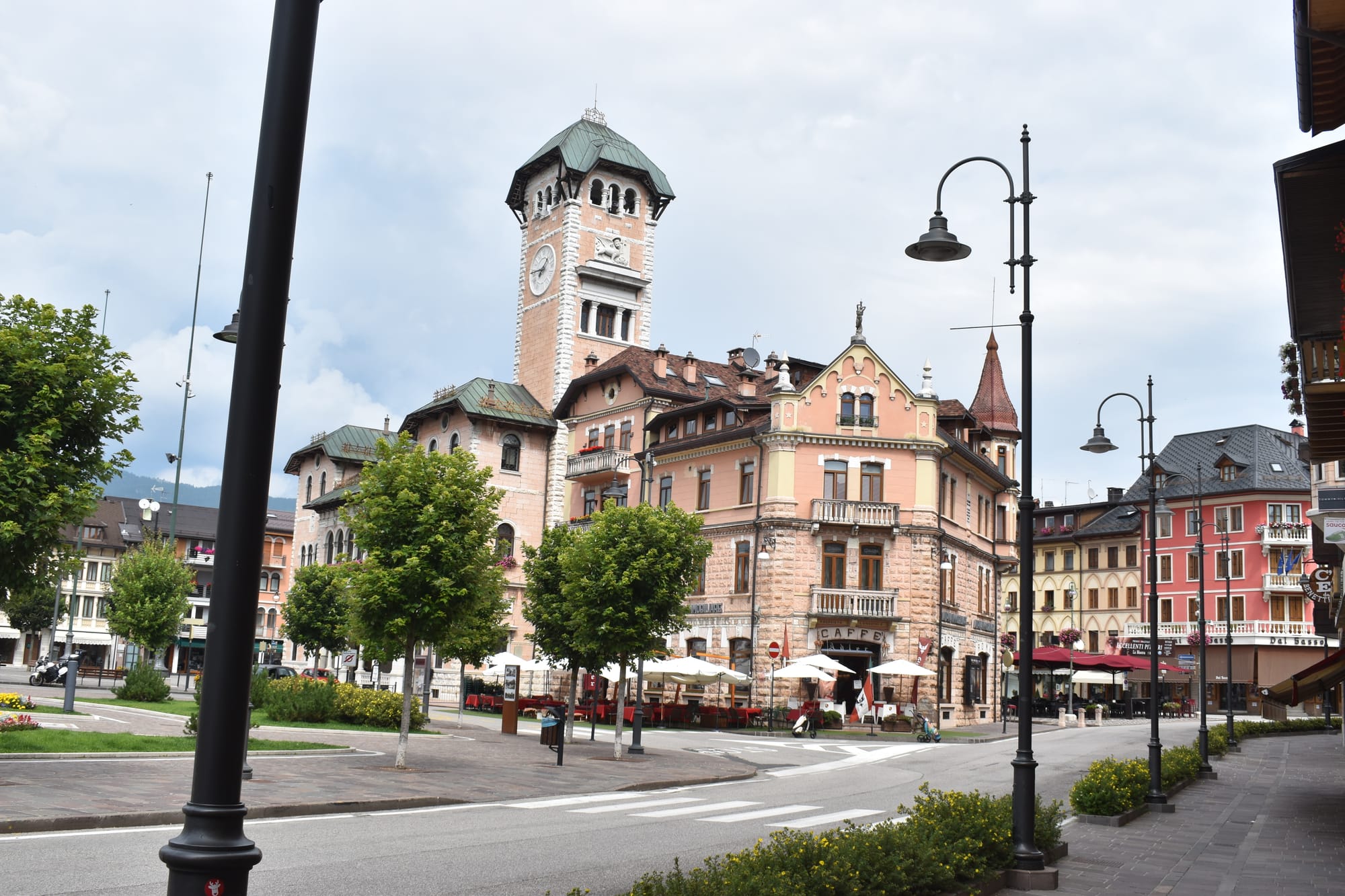 The Cafe Adler in the reconstructed centre of Asiago
The Cafe Adler in the reconstructed centre of Asiago